
다사다난했던2010년을뒤로하고2011년새해를맞이해, MICE산업의미래를조망하고미래변화방향에상응하는전략적대응방안을모색하기 위해 본 지에서는 세계적 미래 학자 로힛 탤워(Rohit Talwar)를 초빙, MICE업계의 앞날과 도래할 이슈들을 살펴보고 그에 따른 대응책을간구해보고자한다. 로힛탤워는영국소재리서치&컨설팅펌인「패스트퓨처리서치」(Fast Future Research)의 CEO로 재직 중에 있으며컨벤션업계의미래를개괄적으로조망한「2020 세계컨벤션연구」(Convention 2020 Global Study)의연구책임을역임했다.

Rohit Talwar
Fast Future Research, CEO
MICE산업의미래변화방향및대응방안
경기침체, 가상이벤트, 팟캐스팅, 소셜 미디어, 인터넷영상회의 비디오, 환경적 요인 등은 기존의 오프라인이벤트모델에 대한 도전요소들로 인식되고 있다. 그러나 이러한 다양한 변화에도 불구하고 이벤트 산업은 존속되어왔으며 신구산업이 공통적으로 요하는 지식 창출 및 공유의 주요요소로 받아들여지고 있다. 그러나 오프라인이벤트가 지속적 성장을 꾀하기 위해서는 획기적이며 혁신적인 형태의이벤트디자인, 홍보, 진행및비즈니스모델이필수적일것으로 판단된다. 패스트퓨처리서치(Fast FutureResearch)의「2020 세계컨벤션연구」(Convention 2020Global Study) 에서는 오프라인이벤트업계에 변화를 불러올 동력요인 및 업계의 진화를 위한 새로운 방안을 살펴보았다.
본 지에서는「2020 세계컨벤션연구」내용 중 다음세가지항목을중점적으로살펴보기로한다.
■ 2011년 ~ 2015년, 업계 주요 이슈 ;
■ 10년 내에 발생할 근본적 변화 ;
■ 업계 리더들이 이러한 변화에 적절히 대응하고 보다 효율적인 향후 전략을 세울 수 있도록 돕는 「의사결정프레임워크
업계 주요 트렌드 2011 ~ 2015
패스트퓨처리서치는「2020 세계컨벤션연구」의 일환으로 2010년 10월 21일부터 11월8일 사이「인식설문조사」를시행하였다. 전 세계 180여명이 설문에 응답했으며 응답자의 50%가 회의, 협회, 여행부문 근로자였다. 설문 참가자들은 2011년 주요이슈 및 향후 2015년까지를 타깃으로 한경영 전략 및 비즈니스 모델을 평가했으며 설문을 통해 이벤트 업계 중 행사 주최자, 협회, 컨벤션센터, 행사개최지,대행사 등 다섯 부문의 이슈들이 분석되었다. 설문의 전체결과는 다음의 프로젝트 웹사이트에서 다운 받을 수 있다.www.convention-2020.com
설문의결과는혁신, 장기적관점, 비즈니스전략에대한비지니스이벤트업계 종사자 및 컨벤션, 트레이드쇼, 회의참관객의 관심이 필수적임을 피력하고 있다. 설문의 주요결과는아래와같이요약할수있다:
▣행사주최자가선별한주요항목은다음과같다.
■2011년주요이슈 – ‘이벤트전반에있어, 소셜미디어의 활용확대’(62%)
■2015년주요전략 – ‘이벤트를통해생성되는지식캡쳐’(58%)
■2015년 형 대안적 비즈니스 모델 – ‘프레젠테이션을 라이브웹형태로유료시청자에게제공’
■협회응답자들은 2011년 주요이슈로‘잠재 참관객들에게 이벤트 참가 혜택 홍보’(65%), ‘치열한 경쟁환경에서 타 행사와 구분될 수 있도록 행사 특화’(58%) 그리고 ‘행사 후원업체 및 참가업체들에게 부가적 혜택 홍보’
(58%)를들었음.
▣컨벤션센터들은 다음의 요인들을 주요항목으로 선별하였다.
■2011년 주요이슈 – ‘고객들의 무료 광대역 통신망 서비스요구에응대’(64%),‘ 저비용운영모델개발’(64%)
■2015년 주요전략 – ‘인터넷 비디오 컨퍼런스실, 3D 프로젝터, 대화형 멀티터치 스크린, 참관객 트랙킹 시스템 등 센터 내 다양한 시설 제공’(63%), ‘이벤트 유치를 위한회의플래닝서비스일절제공’(55%)
■2015년 형 대안적 비즈니스 모델 – ‘레져, 상품판매 등 여러 목적으로 공간 활용을 극대화하여 수입원 다양화 도모’(53%),‘ 경영을외부전문업체에위탁’(51%),‘ 독자적으로 혹은 사업 파트너와 함께 새로운 행사 개발’(50%)
▣행사개최지담당자들이선별한주요항목은다음과같다.
■2011년 주요이슈 – ‘치열한 경쟁 환경에 부합하는 특화 요소발굴’(69%), 개최지홍보에웹/소셜미디어를본격적으로사용’(67%)
■2015년주요전략 – ‘행사주최자및참관객에게개최지에서 행사 주최시의 투자수익률 제시’(63%), ‘행사주최
가지역경제개발에미치는장기적기여제시’(61%)
▣이벤트대행사들이선정한주요항목은다음과같다.
■2011년 주요이슈 – ‘신규고객유치’(75%),‘기존고객 유지’(68%)
■2015년 주요전략 – 응답자의62%가 이벤트 대행사가 ‘고객이 이벤트를 통해 도출된 지식을 캡쳐하고 재사용 할 수 있도록 하는 방안을 제시’해야 한다고 답했으며 61%가‘대행사가 경영컨설팅 회사의 역할’도 수행해야 한다고답했음.
설문결과는고객중심의혁신과개인화는더이상미래의이슈가 아닌 오늘날 우리가 직면한 이슈임을 보여주고 있다. 또한 설문결과에 따르면 참관객들이 행사 진행 중은 물론행사준비과정에도참여하고자하는욕구를갖고있으며이는 참관객이 행사에 적극적으로 참여할수록 행사참여를통해 보다 실질적인 혜택을 얻을 수 있으며 나아가서는 참여행사를대상으로로열티, 즉‘주인의식’을얻을수있음을의미한다.
근본적 변화
위의설문결과의신뢰성를입증하는변화가이미업계에서 감지되고 있으며 이러한 변화는 향후 10년 안에 업계 정황에커다란반향을불러일으킬것으로관측된다. 주요변화의세부내용은다음과같다:
1. 행사구성의 혁신
침체된 경기로 인해 소규모, 저비용, 고집약적 이벤트가 비용 및 시간절감을 원하는 참관객에게 크게 어필할 것으로보인다. (예: 반일/당일 컨퍼런스) 이벤트 디자인 역시 참관객이행사참가로더많은혜택을얻을수있게진일보할것으로 예측된다. 예를 들어「글로브포럼」(Globe Forum)은‘침묵컨퍼런스’모델을 차용하고 있는데, 여기서‘침묵컨퍼런스’란모든브레이크아웃세션을한공간에서플레너리형식으로 진행하는 컨퍼런스로, 참관객들은 멀티채널 헤드폰을착용하고세션발표자의발표내용을구미에따라바꿔가며 청강할 수 있어 자리이동 없이 편리하게 한 공간에서 여러세션에참여할수있다.
2. 행사설계
참관객들의 참여목적에 부합하는 행사를 제공하기 위해 앞으로행사가갖고있는여러가지요소중‘배움의기회’측면에 무게가 실릴 전망이며‘어떻게 참관객에게 배움의 기회를제공할것인가’하는것역시주요한이슈가될것으로관측된다. 이러한이슈들은제공되는세션의유형과시간적분량에서부터참관객의참여정도, 참관객이주체가되는세션의잠재가능성, 행사장레이아웃, 구조화된네트워킹, 제공식음료까지다양할것으로보인다.
3. 세대의 다양화
현대사회의고령화로인해향후주최되는이벤트의디자인은 16세에서 80세 이상의 다양한 세대의 참관객의 여러 가지욕구를두루아우를수있어야할것으로보인다.
4. 소셜 미디어
현재 전 세계적으로 소셜 미디어를 사용하는 인구는 10억명을상회하고있으며이에따라잠재고객을유치하고그들의욕구를이해하는동시에행사기간동안은물론사후에도참관객과 지속적 커뮤니케이션을 가능케 하는 강력한 마케팅 도구가 될 것으로 보인다. 설문결과에 따르면 응답자의63%가 행사 주최자가 무엇보다 주목해야할 이슈로「소셜네트워킹」을지목했다.
5. 상호협동
향후다양한레벨에서보다활발한상호협동이이루어질것으로 보인다. 예를 들어「2009 런던위장컨벤션」(2009London Gastro Convention) 은 다양한 규모의 협회 4개가 통합해 구성한 초대형 전시회로 다양한 행사내용, 후원업체, 참가업체가행사에참여했으며참관객수는15,000명이 넘는 규모였다. 행사 구성과정에서 상호협동이 이루어진 예로는 스위스 제네바에서 열린 리프트 컨퍼런스(LiftConference)를예로들수있는데, 이컨퍼런스에서는참관객들의 욕구를 적극 반응하는 행사를 구성하기 위해 잠재참관객들에게 참여하고 싶은 세션내용을 묻고 이에 상응하여투표결과에의거, 이벤트를구성하였다.
6. 네트워킹
행사 참여자들이 실제적으로 교류하고 실질적으로 도움이될 만한 업계 인맥을 쌓을 수 있도록 네트워킹에 앞으로 더큰무게가실릴것으로보인다.
7. 지식캡쳐
최근 업계에서는 행사를 통해 도출된 지식재원을 캡쳐하고재사용하는것의중요성이강조되고있는추세이다. 기존에는 행사에 사용된 비디오 혹은 오디오 세션 내용들이 행사종류 이후에 파기되어 행사를 직접적으로 참여한 참관객들만 그 혜택을 누릴 수 있었다. 패스트퓨처리서치에서 시행한 여러 설문 중 한 설문의 응답내용을 살펴보면 설문 참여자의93%가행사를통해도출된지식정보를저장하고향후참가자의 소속 기관에 몸담고 있는 직원 모두가 공유할 수있도록하는방안이간구되어야한다고답했다.
8. 개인특화된 지식습득경로
신경과학분야가 발전을 거듭함에 따라 오늘날 우리는 인간의 지식습득 방법 및 경로에 대해 상세히 알게 되었으며 일례로 인류의 유전도(遺傳圖)는 무엇의 인간의 수행능력을저하 혹은 배가 시키는지 제시하고 있다. 다양한 기술혁신이 이루어지며 조정 가능한 가구, 증강현실(增强現實- 실세계에3차원가상물체를겹쳐보여주는기술), 전방시현기,손동작인식 인터페이스 등 다양한 기술개발이 이루어지고있다. 이러한 기술혁신으로 인해 우리는 앞으로 지금보다더 개인 특화 된 형태의 지식습득경로를 경험하게 될 것으로 보이며 설문응답자의 80%가 2020년에 이르러 완벽한지식습득경로개인특화가이루어질것으로예상하고있다.
9. 후원사와 참가업체
경기침체로 인해 후원사와 참가업체의 투자비용 대비 수익에 대한 요구가 점차 까다로워지고 있는 추세이며 이에 따라 투자수익률제시와 선택의 다양화가 필요할 것으로 관측된다. 설문에 따르면 응답자의 60%가 향후 투자 상환을 결과로 제공하는 효율적 비즈니스 모델을 볼 수 있으리라 예측한다고답했다.
10. 비즈니스모델
과열경쟁과 제한된 예산으로 인해 행사주최자들은 점차 행사 주최를 통한 이윤창출에 회의적인 반응을 보이게 될 것이며 대안적 수익창출수단을 찾게 될 것으로 전망된다. 이러한 대안적 수익창출수단으로는 행사를 라이브로 유료시청자들에게 온라인으로 제공하거나 행사 세션들을 행사 사후에 시청자들에게 유료시청제로 제공 혹은 행사내용을 패키지화해 행사 참관객과는 다른 타깃의 참관객을 대상으로재판매하는방법등을들수있다. 설문응답자의76%가앞으로 행사관련 상품 및 서비스를 행사장에서 구입하게 될수있을것이라예측하고있다.
11. 행사장 디자인
용적증가, 새로운 센터설립, 과열경쟁 등으로 말미암아 행사장들에 있어‘혁신’이 필수생존요소가 될 것으로 관측된다. 최근패스트퓨처리서치가시행한업계설문에의하면응답자의 60% 이상이 저비용, 공간 활용의 유동성, 운영비용절감, 최신A/V기술구비등을주요이슈로꼽았다. 설문참여자의55%가대형협회의행사를유치하기위해센터들이다양한 서비스 제공을 통해 PCO와 직접경쟁구도를 펴야할것으로관측한다고응답했다. 또한응답자의42%는센터들이 상품판매, 레져활동 제공 등을 통해 대안적 수익창출방안을 찾을 것이라고 전망했다. 이와 같은 이슈들은 향후 행사장디자인에상당한영향력을행사할것으로보인다.
12. 경제적 가치
행사 개최지, 행사장 그리고 협회는 담당 컨퍼런스 참여를통해 획득 가능한 장기적 혜택을 입증하기 위해 다양한 방안을 찾을 것으로 예상된다. 일례로 호주의 시드니에는 의료컨퍼런스의 성공적 개최결과로 다수의 리서치 센터들이설립 되었다. 행사개최의 총 가치가 높을수록 참관객, 후원기관, 참가업체모두에게더크게어필할수있게된다.
미래계획 – 의사결정들
위에서 언급했던 주요이슈들과 변화요인들로 인해 오늘날이벤트업계의리더들은장기적비즈니스전략을구성하기위해다양한선택과결정의기로에놓여있다.리더들이직면한이슈들과이에따른주요결정사안들을정리해보면아래표와같다:
맺음말
세상 모든 것이 그러하듯, 사실상‘미래’가 불러올 변화를 우리 모두가 동시에 느낄 수는 없다. 어떤 이들은 이미새로운 아이디어를 상용화하는 선구자의 길을 걷고 있는가하면 그러한 변화를 먼 미래에 다가올 일로 간주하는 이들도 있다. 우리 연구의 결론은 현재로써 이벤트 업계 자체의존폐를장담할수는없지만, 분명한것은앞으로다가올변화에전략적으로대응한다면이벤트업계의미래는밝을것이라는것이다. 이벤트업계가향후이벤트컨셉, 디자인그리고 비즈니스 모델을 꾸준히 혁신시키고 변화시킨다면 비즈니스, 전문·과학지식의창출과분배에있어중요한역할을수행하게되리라예상한다.

[영문 원문]
The Future of Business Events
Economic downturns, virtual events, podcasting, socialmedia, telepresence video and environmental pressureshave all been cited as potential challenges to the live eventmodel. However, despite all of these developments, thesector has survived and is increasingly recognised as acritical component in the creation and sharing ofknowledge for old and new industries alike. However, forlive events to thrive in the decade ahead, we will need tosee widespread innovation in the design, promotion,delivery and business models for such events. In theConvention 2020 global study (www.convention-2020.com) we are exploring the drivers of change for livebusiness events and examining new and emerging ideas onhow the live event experience will need to evolve.
In this article, I draw on the Convention 2020 research to examine three topics:
*emerging industry priorities for 2011-2015
*the underlying changes we can expect to see in the decade ahead, and
*a decision making framework to help leaders respond to these developments and craft their future strategies.
Industry Priorities 2011 – 2015
As part of the Convention 2020 study, a ‘Pulse survey’was run from October 21st to November 8th 2010 and wascompleted by 180 respondents around the world, with50% working in the meetings, association or travel sectors.The survey asked participants to assess priorities for 2011and strategies and business models for the sector out to2015. The survey looked at these issues for five keysectors of the industry – event owners, associations,convention centres, destinations and event agencies. Thefull results can be downloaded from the project websitewww.convention-2020.com
The survey highlights that importance being placed on theneed for innovation, longer term thinking and closerattention to strategy both by those within the businessevents industry and those who attend its conventions, tradeshows and meetings. The key findings of the survey aresummarized below.
For event owners the highest ranked factors were:
*2011 priorities – ‘extending the use of social mediaaround the event’ (62%)
*Key 2015 strategies – ‘greater focus on capturing the knowledge generated at an event’ (58%)
*Alternative business models for 2015 – ‘presentations streamed live to web for pay per view’ (67%)
*For associations in particular the 2011 priorities were to ‘demonstrate event benefits to potential delegates,’(65%),
*‘differentiate events in the face of increased competition,’ and ‘identify additional benefits for sponsors and exhibitors,’ (both 58%).
For convention centres the highest ranked factors were:
*2011 priorities – ‘respond to the demand for free broadband wireless access’ (64%), and ‘create lower cost operating models’ (64%)
*Key 2015 strategies ? ‘offer a wide range of in house facilities such as telepresence video onferencing suites, holographic projection, interactive surfaces and delegate tracking’ (63%), and ‘offer a full meeting planning service to help attract events’ (55%).
*Alternative business models for 2015 – ‘turning space over to activities such as leisure and retail to diversify revenue’ (53%), ‘outsource management to third party specialists’ (51%), and ‘create
new events alone or with partners’ (50%).
For destinations the highest ranked factors were:
*2011 priorities – ‘find differentiators in the face of intense competition’ (69%), and ‘use web/social
media more to promote the destination’ (67%)
*Key 2015 strategies – demonstrate the return on investment for event owners and delegates from
hosting a meeting in this destination’ (63%) and ‘demonstrate the longer term contribution to local
economic development of hosting a business event’(61%).
For event agencies the highest ranked factors were:
*2011 priorities – ‘attract new customers’ (75%) and °Æmaintain the existing customer base’ (68%)
*Key 2015 strategies – 62% believe agencies will have to ‘develop solutions which help clients capture and re-use the knowledge generated at events’ and 61% expect agencies to ‘look more like management consultancies’ by 2015
The survey highlights that customer focused innovationand personalization are no longer issues to be put off untiltomorrow. Participants are also increasingly expectingand wanting to have far greater input both during thedesign phase and during the event itself. The implicationis that the more we can engage them, the more likely theyare to gain tangible benefits and feel a higher degree ofloyalty to and ‘ownership’ of the event itself.
Underlying Changes
Underpinning the findings of the Pulse survey are a set ofchanges taking place in the industry that will see thebusiness event industry landscape evolve in quitedistinctive ways over the next decade. A number of thesekey changes are explored in more detail below.
Format Innovation – In financially challengedeconomies in particular, smaller, cheaper and morehighly focused events will proliferate in response todelegate pressures to save time and money – e.g. half dayand one day conferences. The design itself will alsochange to help delegates get the most out of theirattendance. For example the Globe Forum(http://www.globeforum.com) uses a ‘silent conference’model where all of the breakout sessions are held in thesame room as the plenary. The breakout speakers presentat separate screens around the room while delegates listenthrough multi-channel headphones – enabling them toswitch between sessions without leaving their seats.
Event Architecture – The pressure to deliver on delegateobjectives will ensure a far greater emphasis is placed onthe overall design of the learning experience and theelements through which it is delivered. This will includeeverything from the length and type of sessions offered,levels of interaction, potential for audience generatedsessions, physical event space layouts and structurednetworking, through to the food and beverages served.
Generational Diversity – As society ages and lifespansincrease, event designs will need to cater for the differingneeds of a potential audience that ranges in age from 16 to80+.
Social Media – With over a billion members worldwide,the social networks will become a powerful tool forreaching potential audiences, understanding their needs,and engaging them in a dialogue before during and afterthe event. In the Pulse survey 63% ranked socialnetworking as the top priority for event owners.
Collaboration – We will see greater collaboration atdifferent levels. For example the 2009 London GastroConvention (http://www.asnemge.org) bought togetherfour different associations of different sizes to createsomething on a scale which none of them could deliveralone- allowing them a broader range of content, sponsorsand exhibitors and delivering over 15,000 delegates. Atthe design level – events like Lift (http://liftconference.com) in Geneva ask potential attendees topropose the bulk of the sessions and the delegates thendesign the event by voting on those sessions which they’dmost like to attend.
Physical Networking – More attention will be paid tofacilitating physical networking to ensure people meet andmake valuable connections.
Knowledge Capture – There is a growing emphasis inbusiness on capturing and re-using knowledge from everyactivity. While some events video or audio capturesessions, the bulk of the content is lost to all but those whoattend. In future, 93% of respondents to one of our surveysfelt far greater emphasis will be placed on finding ways tocapture the content from an event and share it witheveryone in a delegate’s organisation who wants access toit.
Personalised Learning Experiences – Advances inneuroscience are providing deeper insights into how welearn. Mapping of the human genome is providing agreater understanding of what drives and hinders ourperformance. Technology breakthroughs are bringingdevelopments such as adaptive furniture, augmentedreality, virtual reality, ‘heads up’ displays and gestureinterfaces. These advances and others will combine toenable us to deliver the far more personalised learningexperiences – our research found that 80% expect totalpersonalisation by 2020.
Sponsors and Exhibitors – Harsher economic times, agreater focus on proving return on investment andwidening choice are enabling sponsors and exhibitors tobe more demanding in terms of what they get for theirmoney. Our research found that over 60% believe we willsee a range of new business models which effectivelyoffer a greater element of payment by results.
Business Models – Competition and budgetary pressureswill challenge event owners’ profit expectations and theywill increasingly look for ancillary revenue streams. Thesecould include live streaming of events to a paying webaudience, selling sessions on a pay per view basis after theevent, packaging up event content for resale to differentaudiences and merchandising. Indeed 76% expect to beable to purchase products and services on the spot.
Venue Design – In the face of greater capacity, newentrants and intense competition venues will be forced toinnovate. In our latest industry survey, over 60% selectedeach of the following as priorities – lower prices, offeringgreater flexibility on how their space is used, driving downoperating costs and increasing the sophistication of theaudio-visual technology offering. 55% felt venues willalso find themselves offering a wider range of services toenable them to compete directly with professionalconference organisers to win the business of the largeassociations. 42% felt venues would seek out ancillaryrevenue streams through retail and other leisure activities.All of these will have an impact on venue design in thefuture.
Economic Value – Destinations, venues and associationswill increasingly seek to prove the long term benefits fortheir particular conferences. For example, Sydney canpoint to research centres that were created on the back ofmedical conferences they attracted to the city. The greaterthe total value of the event, the more attractive it becomesto delegates, sponsors and exhibitors alike.
Planning the Future – a Decision Making FrameworkGiven the priorities and drivers of change outlined above,leaders in the industry face a number of key decisions andchoices as they develop their longer term strategies.The framework below sets out a number of thesechallenges and the key choices to be considered inaddressing them.
Conclusions
As always, the future does not arrived at a universal rateand while some may see these changes as a long way off,others are already pioneering the ideas. While survival isnot guaranteed, our research suggests that the industry hasan excellent future should it choose to think and actstrategically in the face of the drivers of change thatconfront it. The live event industry can play an increasinglyvital role in the creation and dissemination of business,professional and scientific knowledge if it can continue toinnovate on event concepts, designs and business models.


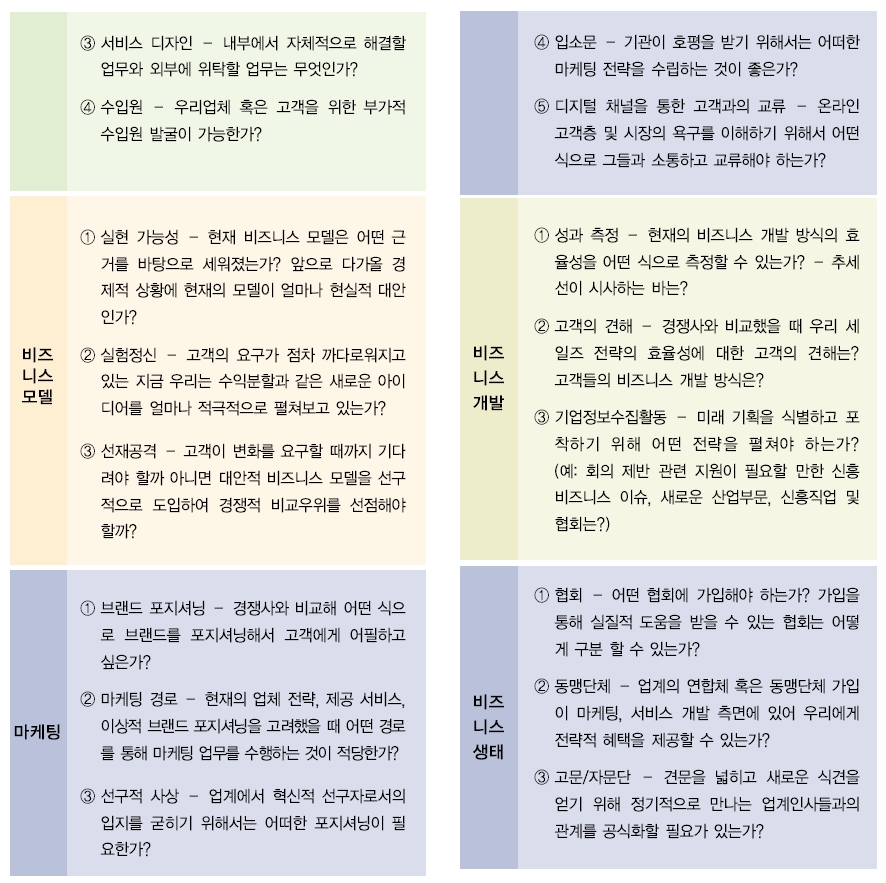
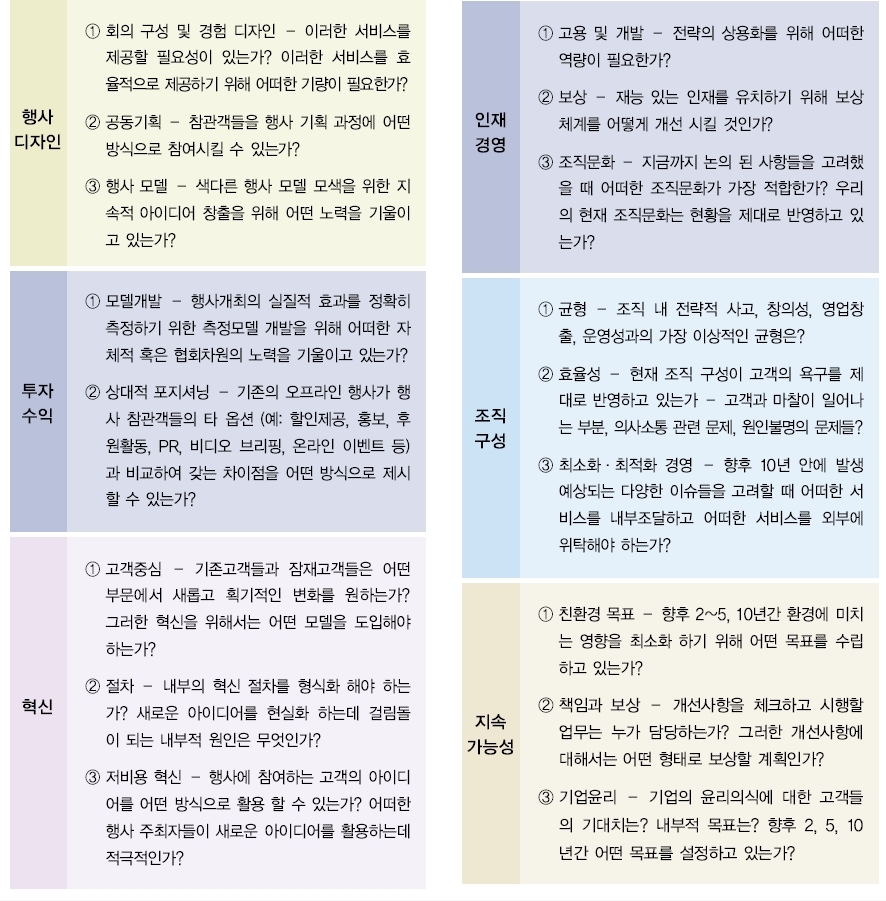
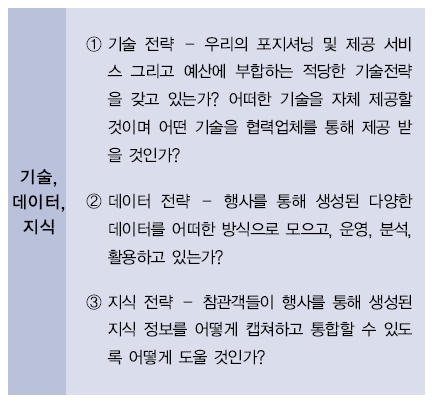
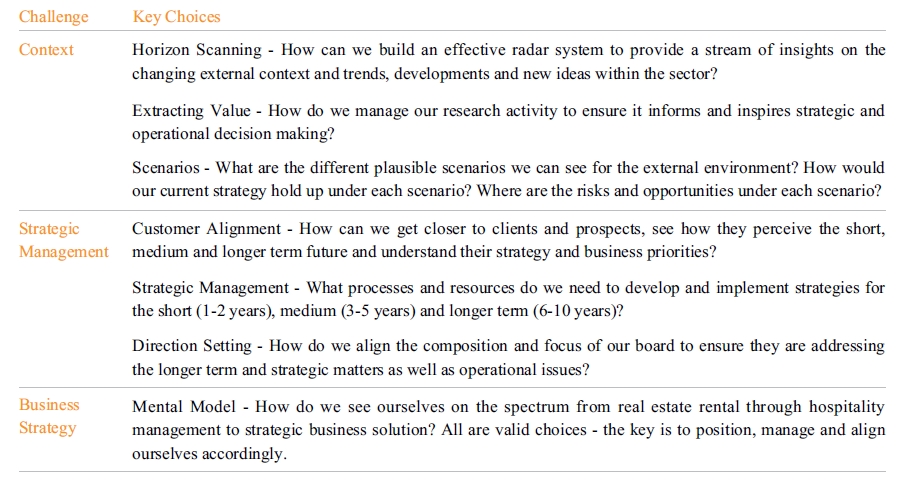
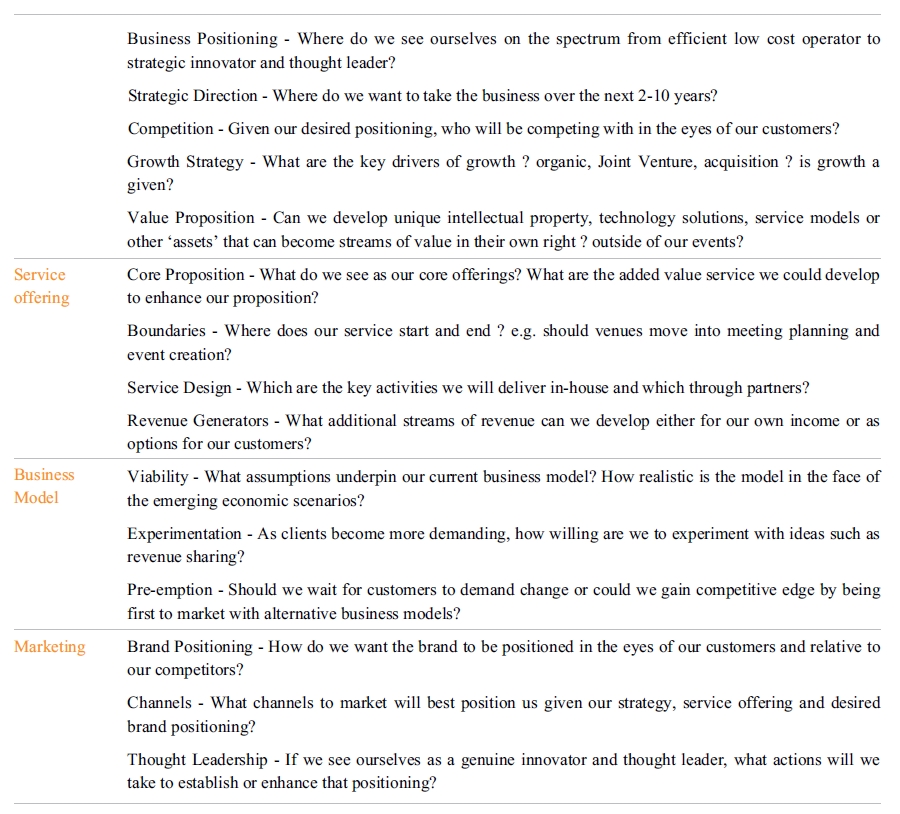
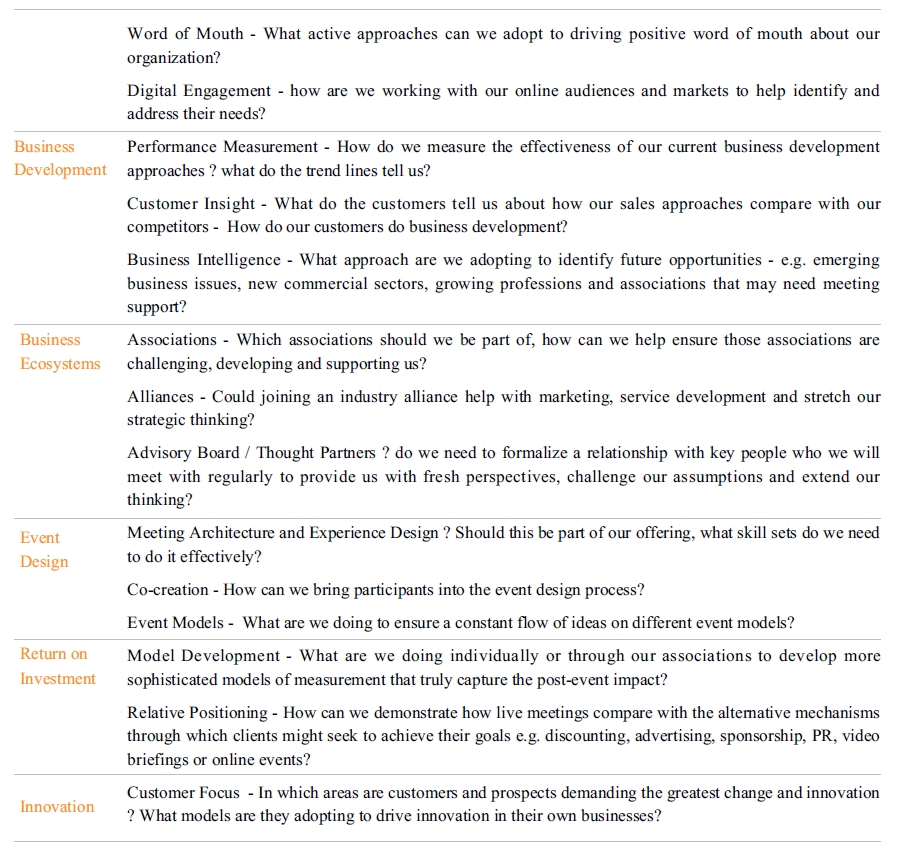
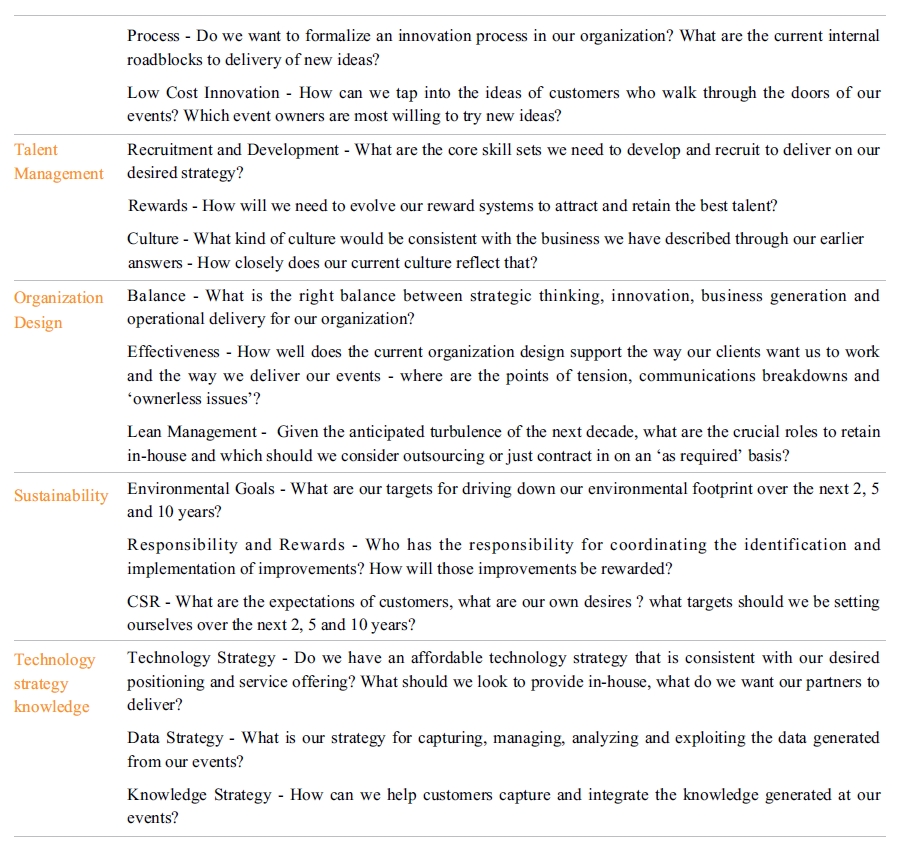

![[편집장 칼럼] 컨벤션3.0과 컨벤션 기획력](https://miceinsight.co.kr/wp-content/uploads/2012/05/2_26.jpg)
![[편집장 칼럼] 대한민국 MICE산업의 ‘애플쇼크(Apple Shock)’를 기대하며](https://miceinsight.co.kr/wp-content/uploads/2012/05/2_110.jpg)

